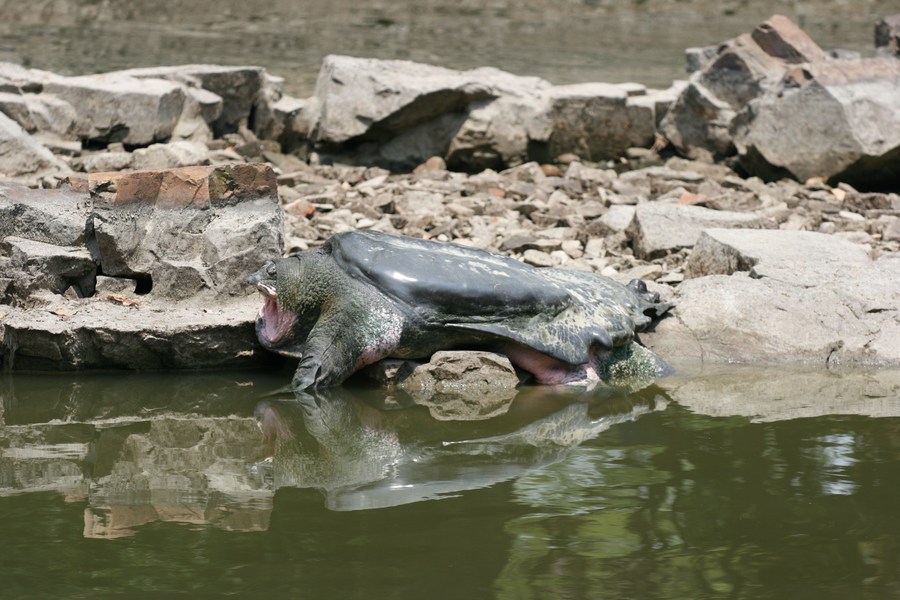
This file photo taken in 2008 shows a male Swinhoe's softshell turtle (Rafetus swinhoei) living in the Suzhou Zoo in Suzhou, east China's Jiangsu Province. (Xinhua)
by Xinhua writers Yao Yulin, Yue Ranran
KUNMING, June 26 (Xinhua) -- Many wept for the death of Lonesome George, the last known survivor of the Pinta Island tortoise subspecies, about a decade ago. Yet, here comes an even more desperate truth: the Earth's last two Swinhoe's softshell turtles (Rafetus swinhoei) are both males, starting a cruel countdown on the species' extinction.
Critically endangered as listed by the International Union for Conservation of Nature (IUCN) Red List of Threatened Species, the two belong to the world's largest and rarest living turtle species. One is in Vietnam, while the other is in the Suzhou Zoo, east China's Jiangsu Province.
Under top-level protection in China, the wildlife has a profound cultural bond with the Chinese. It was a frequent story prototype in scenes of ancient classic novels, including "A Dream of Red Mansions" and "Journey to the West."
Its extermination, though seemingly only a matter of time, is yet to come in the eyes of some firm-minded researchers. They are still in a tireless search for the species' possible survivors in vast expanses of water in southwest China.
SORROWFUL DEATH OF LAST FEMALE TURTLE
In April, Vietnam announced the much-lamented death of the only female Swinhoe's turtle on Earth -- the last straw to push the species close to extinction. Coming to existence on the planet hundreds of millions of years ago alongside dinosaurs, the turtle has good reasons for being on the verge of dying out.
Often confused with the Asian giant softshell turtle, the Swinhoe's softshell turtle was not identified as a new subspecies until 1993, when a Chinese biologist drew his conclusion built upon abundant studies.
As the world's largest freshwater turtle, the wildlife once widely inhabited China's major rivers and lakes, such as the Yellow River, Yangtze River, and Taihu Lake. It is also known as the "Yangtze Giant Softshell Turtle." Nevertheless, it had been mistaken for other subspecies for ages, with hardly any attention paid to the endangered, making the turtle near extinct as soon as humans understood its true identity.
In 2005, when the only Swinhoe's turtle in Beijing Zoo died, it had just been confirmed to belong to the species a year earlier. Likewise, another one in Shanghai Zoo died less than three months after being identified in 2006.
Lyu Shunqing, professor and dean of the School of Life and Environmental Science at Huangshan University, attributed its near-extinction to three respects: the solitary animal tends to guard its territory at all costs, causing fierce intraspecies competitions; its giant shape demands huge food reserves, and thus it needs a vast expanse of water, while frequent human activities over the years have gnawed away its natural habitats; false belief that eating the turtles can lead to longevity has also fueled overhunting of the wildlife.
"Since 1972, we have never spotted Swinhoe's turtles in Taihu Lake. Currently, the only possible and suitable habitat for wild Swinhoe's turtles in China is the Honghe River," the expert added.
Lyu has a permanent scar on his right thumb, a bite by the rare turtle for the first time and probably the last time. It was left by China's then-only female Swinhoe's turtle named "Xiangxiang," once the only hope for the scientists to propagate the wild species.
Xiangxiang, in her nineties and still able to lay eggs, was protected by Changsha Zoo, central China's Hunan Province, in 2007. Back then, it was the only female turtle of the species to be confirmed globally. One year later, she was sent to Suzhou for possible natural mating with a male.
However, attempts in the following six years were in vain due to the poor semen quality of the male turtle aged over 100 then. Later on, researchers found that his penis was severely injured, probably in a fight with other males.
Though a shot in the dark, scientists from home and abroad performed several artificial insemination surgeries from 2015 to 2019.
It was when pinning Xiangxiang for the anesthetic injection before the last surgery in April 2019 that Lyu got bitten. After the surgery, the animal didn't wake up as she was supposed to. The next day, she died.
Lyu and his colleagues had no time to outpour their grief. The researchers soon preserved Xiangxiang's ovarian tissue in liquid nitrogen while other experts did a pathological anatomic examination of her body to save critical genomic information about female Swinhoe's turtles.
Rao Dingqi, an expert in amphibians and reptiles from the Kunming Institute of Zoology under the Chinese Academy of Sciences, participated in the examination. "The DNA sequence can be of great significance to future search for the surviving individuals of the species. Using tailored genetic, molecular probes, we can more effectively detect potential Swinhoe's turtles in the wild based on collected environmental data," he explained.
Some may wonder why intelligent humans didn't adopt cloning technologies on the species. The sad fact is cloning mammals may be relatively feasible but not practicable regarding turtles relying on hatching eggs to reproduce.
"When the population of a species has already declined to such a level as the turtle, its gene pool is no longer complete and possible to be restored. Even if we could clone an individual turtle, it is another story to bring the whole species back to life," said Zheng Ping, a researcher from the same institute.
SEARCH FOR WILD SURVIVORS
One month later, after Vietnam announced the death of the Earth's last female Swinhoe's turtle, Rao and Lyu set forth on their wandering journey in search of possible survivors of the species in Madushan Reservoir, southwest China's Yunnan Province.
Situated in Yunnan's Honghe Hani and Yi Autonomous Prefecture near the Honghe River, the reservoir stretching over 50 km is their last hope to rescue the wildlife.
Local fisherfolk have spotted giant turtles resembling the Swinhoe's ones during sunny days after the reservoir started operation in 2007. Years ago, some even found such A turtle floating on the river due to illegal hunting using electricity.
In May, the scientists walked miles along the banks, setting up cameras and monitoring via binoculars at locations where the species were likely to appear. Water samples were also collected to detect matching DNA information using those they got from the dead Xiangxiang.
The long, tiring hours of wandering, searching, and sampling are like "looking for the Loch Ness Monster," a mythical marine creature. "We are making similar attempts to find our 'Madushan Monster,'" quipped Lyu.
In the Greek myth, the hero Odysseus wandered for a decade trying to return home after the Trojan War. Though a long haul, his expedition proved worthwhile at last. The Chinese scientists are not afraid of an exhausting search for the Swinhoe's turtles, only hoping they could have a similar happy ending.
They have even planned in detail what to do next if they are lucky enough to discover any: instant on-site protection and monitoring, expansion in further search, natural mating attempts, and future international cooperation with Vietnam.
"It's crying over spilled milk if all we have is regret. What we should truly care about is how to prevent the extinction of species in advance," Rao said.
"Extinction means never a second chance to bring the wildlife back to life. It sounds heartwrenching, yet a sobering thought for us," Lyu said. ■












